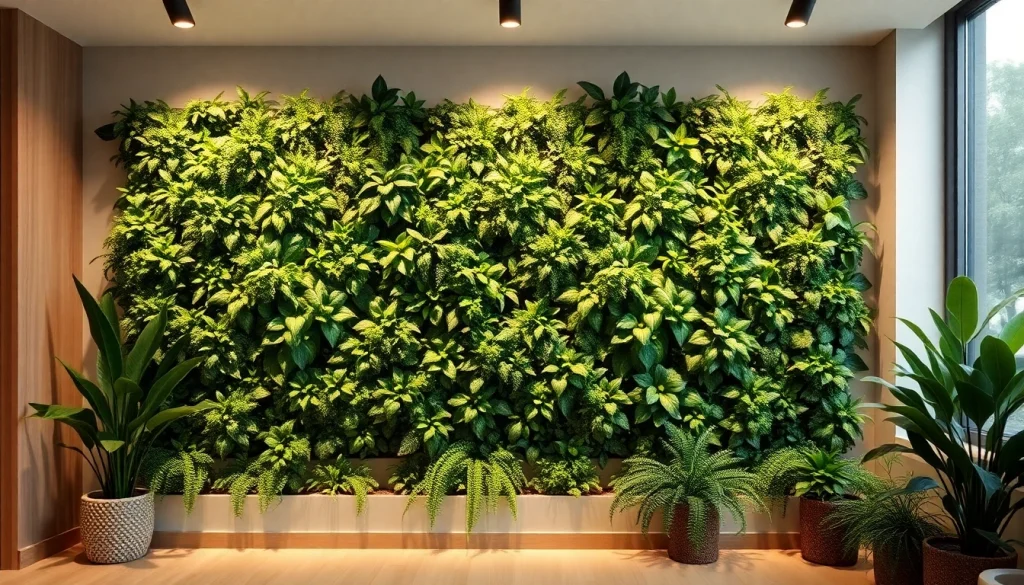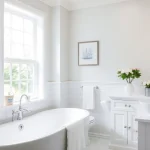Understanding Wandbegrünung Indoor
What is Wandbegrünung Indoor?
Wandbegrünung Indoor, or indoor vertical gardening, is a revolutionary approach to integrating nature into indoor spaces using vertical structures. This innovative gardening method entails growing plants on walls, utilizing systems that support plant growth and flourishing without requiring expansive floor space. Ideal for apartments, offices, and commercial spaces, indoor vertical gardens consist of various plants arranged on specially designed panels or frames that can thrive in distinct environmental conditions. By embracing this technique, individuals can enhance aesthetics, improve air quality, and create a serene environment within their interiors. Indoor vertical gardens not only serve as a focal point but also function as a living artwork that continuously evolves with the changing seasons. For anyone looking to explore the transformative power of these gardens, it’s worth diving deeper into the benefits and considerations associated with Wandbegrünung Indoor.
Benefits of Indoor Vertical Gardens
The advantages of implementing an indoor vertical garden are multifaceted, appealing to both aesthetic sensibilities and practical needs. Key benefits include:
- Space Efficiency: Vertical gardens maximize small spaces, making it possible to incorporate greenery where traditional gardening would be impractical.
- Air Quality Improvement: Indoor plants naturally filter pollutants and detoxify the air, promoting a healthier living environment.
- Enhanced Aesthetic Appeal: The visual impact of a green wall can dramatically transform an area, adding color, texture, and a touch of nature, enhancing overall design.
- Noise Reduction: Plants have been shown to absorb sound, which can help reduce noise pollution in urban environments.
- Increased Humidity: Plants transpire, releasing moisture into the air, which is beneficial especially in heated indoor environments that tend to be dry.
- Psychological Benefits: Studies suggest that having plants indoors can reduce stress, enhance mood, and increase productivity—a key consideration for workplaces.
Choosing the Right Plants for Your Space
Choosing appropriate plants for your indoor vertical garden is critical to ensuring its success. Factors to consider include light availability, humidity levels, and temperature. Here are some optimal choices:
- Low Light Plants: Consider plants like Ferns, Snake Plants, and Pothos, which thrive in low-light conditions.
- Moderate Light Plants: Spider Plants and Peace Lilies do well in spaces with indirect natural light.
- High Light Plants: Succulents, Cacti, and certain herbs like Basil and Thyme require more sunny spots.
- Foliage vs. Flowers: Decide if you want a vibrant floral display or the lush greenery offered by foliage plants. Both can create a dynamic visual impact.
Ultimately, your personal taste, maintenance capabilities, and specific environment will dictate the best plant choices for your indoor vertical garden.
Designing Your Wandbegrünung Indoor
Planning Your Layout and Design Concept
The design of an indoor vertical garden should meld seamlessly with your existing space while fulfilling your aesthetic goals. Start by measuring your wall space and considering which areas could benefit from a touch of greenery. Here are some points to guide your design process:
- Wall Area: Identify walls that are strategically placed for visibility and accessibility.
- Design Style: Match the vertical garden design to your home’s existing style, whether contemporary, minimalist, or bohemian.
- Color Selection: Choose plants that complement the room’s color palette for a cohesive look.
- Access to Water and Light: Plan the garden’s location to ensure that plants receive adequate light and can be easily watered.
Using sketches or digital design tools, visualize how your plants will be arranged and how they will interact with the surrounding elements.
Optimal Wall Structures for Plant Growth
The choice of wall structure will significantly influence the health of your indoor garden. Efficient wall systems provide the necessary support to plants while ensuring proper drainage and access to nutrients. Popular options to consider include:
- Modular Plant Panels: These consist of pre-assembled sections that make installation easy while allowing for customization.
- Living Walls: A more permanent solution, living walls are built into the structure of the building and are often automated for irrigation and nutrient delivery.
- DIY Frameworks: For a more budget-friendly solution, repurpose wooden pallets or create custom shelves for potted plants.
Choose materials that are durable, water-resistant, and capable of supporting the weight of the plants and soil without compromising the structural integrity of the wall.
Incorporating DIY Solutions for Budget-Friendly Options
For those looking to create an indoor vertical garden without overspending, DIY solutions can be a fantastic approach. Here are some budget-friendly ideas:
- Repurposed Items: Use old pallets, crates, or even shoe organizers to create vertical planting systems.
- Hanging Planters: Consider repurposing hanging planters or using recycled materials, such as plastic bottles or tin cans, as planters.
- Wire Mesh Grids: Create a simple frame using wire mesh to hang pots or plants and allow for vertical growth.
DIY options can often be more customizable, allowing you to fine-tune the aesthetics to fit your space while making the project more enjoyable.
Installation Process for Wandbegrünung Indoor
Tools and Materials Needed
Before diving into the installation of your indoor vertical garden, ensure you have all the necessary tools and materials:
- Plants suitable for the vertical environment
- Planting medium (soil or hydroponic systems)
- Frames or panels (bought or DIY solutions)
- Watering system (manual watering tools, drip irrigation system)
- Tools (screwdriver, drill, measuring tape, level)
- Safety gear (gloves, goggles)
Preparation ensures a smoother installation process and helps prevent common issues related to plant health and structural stability down the line.
Step-by-Step Installation Guide
The installation of your vertical garden can be broken down into the following steps:
- Choose Your Location: Identify a wall with suitable light conditions and minimal obstruction.
- Preparation of the Wall: Clean the wall and ensure it’s sturdy enough to hold the structure.
- Install the Structure: If using panels, secure them to the wall using appropriate fasteners. Ensure they are level.
- Planting: Prepare your plants in advance, ensuring they are trimmed and healthy. Insert them into the planting medium according to your design.
- Irrigation Setup: Install a watering system if using one, ensuring it is functional and tested.
- Final Adjustments: Step back and assess your work, making any last-minute adjustments to the positioning of plants.
Take your time during installation to ensure everything is correct; this will save you hassle in the long run.
Common Installation Mistakes to Avoid
During the process of installing your indoor vertical garden, there are a few common pitfalls to watch out for:
- Neglecting Light Conditions: Ensure plants selected for shaded areas do not require intense sunlight and vice versa.
- Poor Moisture Control: Be cautious with irrigation systems. Overwatering can lead to root rot.
- Incompatible Plant Choices: Avoid mixing plants with drastically different care requirements, as this can complicate maintenance.
- Ignoring Maintenance Needs: Select plants that match your ability to commit to regular care and maintenance.
Learning from installation mishaps can ensure you create a sustainable and thriving indoor vertical garden.
Maintaining Your Indoor Vertical Garden
Watering and Nutritional Needs of Indoor Plants
Establishing a consistent watering schedule is essential for the health of your indoor vertical garden. Consider these points:
- Watering Techniques: Depending on your plant selection, methods may include top watering, bottom watering, or a drip irrigation system.
- Frequency: Monitor the moisture level of the soil or medium and water appropriately—typically once a week or more depending on plant needs.
- Nutritional Supplements: Utilize organic fertilizers tailored to your chosen plants, following recommended application rates.
Being attentive to these needs can prevent issues related to nutrient deficiency or overwatering, fostering a healthier garden.
Pruning and Care Tips for Healthy Growth
Regular maintenance will keep your vertical garden looking pristine and ensure plant vitality. Follow these care tips:
- Regular Pruning: Remove any dead or yellowing leaves to promote healthy growth and avoid diseases.
- Rotation of Plants: Occasionally rotate plants for even light exposure, especially in unevenly lit spaces.
- Keep an Eye on Growth: Regulate growth by trimming back overly aggressive plants to maintain the desired aesthetic.
With consistent attention and pruning, your vertical garden can flourish for years to come.
Handling Pests and Diseases in Indoor Gardens
Indoor vertical gardens can be susceptible to various pests and diseases. Here are some strategies for effective management:
- Regular Inspection: Routinely check your plants for any signs of pests such as aphids, spider mites, or mealybugs.
- Natural Remedies: Use organic insecticides or tried-and-true home remedies like neem oil for pest management.
- Isolation: If you discover a pest issue, isolate infected plants to prevent the spread.
- Healthy Plants: Promoting overall plant health through proper care significantly reduces susceptibility to pests and diseases.
Maintaining vigilance and promptly addressing issues will ensure your vertical garden remains resilient and vibrant.
Showcasing Successful Wandbegrünung Indoor Projects
Case Studies of Stunning Indoor Vertical Gardens
The success of Wandbegrünung Indoor can be evidenced through several stunning projects that have embraced this green space innovation. Case studies vary from residential implementations in cozy apartments to large-scale installations in corporate offices. Highlighted examples include:
- Residential Projects: Small apartments utilizing modular vertical gardens not only beautify living spaces but also allow inhabitants to cultivate fresh herbs and plants for home cooking.
- Corporate Installations: Businesses incorporating living walls into their employee spaces report increased employee satisfaction and lower stress levels, showing the real benefit of investing in greenery.
- Commercial Spaces: Restaurants and cafes have benefited from the stylish and inviting atmosphere created by lush green walls, directly impacting their customer experience.
These positive outcomes demonstrate how well-planned indoor vertical gardens can transform various environments, fostering joy and well-being.
Client Testimonials and Transformations
Client insights provide a personal touch to the impact of indoor vertical gardens. Consider the following comments:
“Our office space was completely transformed with the addition of a vertical garden. Not only does it look incredible, but we can also enjoy fresh herbs in the kitchen.” – A Corporate Client
“Creating a vertical garden in our apartment allowed us to bring nature indoors and truly elevated our living space.” – A Residential Client
Personal experiences highlight how indoor vertical gardens create emotional connections between occupants and their spaces.
Inspiration from Experts in Indoor Gardening
Expert horticulturists and designers offer a wealth of inspiration for maximizing indoor vertical gardens. Emerging trends focus on:
- Using Native Plants: Experts suggest incorporating native plants into designs to encourage biodiversity and create more sustainable gardens.
- Smart Technology: The integration of smart technology for irrigation and plant health monitoring is revolutionizing garden maintenance.
- Artistic Arrangements: Creative designs that incorporate unconventional materials and shapes inspire unique expressions of indoor gardening.
Staying informed about trends and insights from industry leaders can provide fresh ideas that challenge conventional approaches to indoor vertical gardening.


